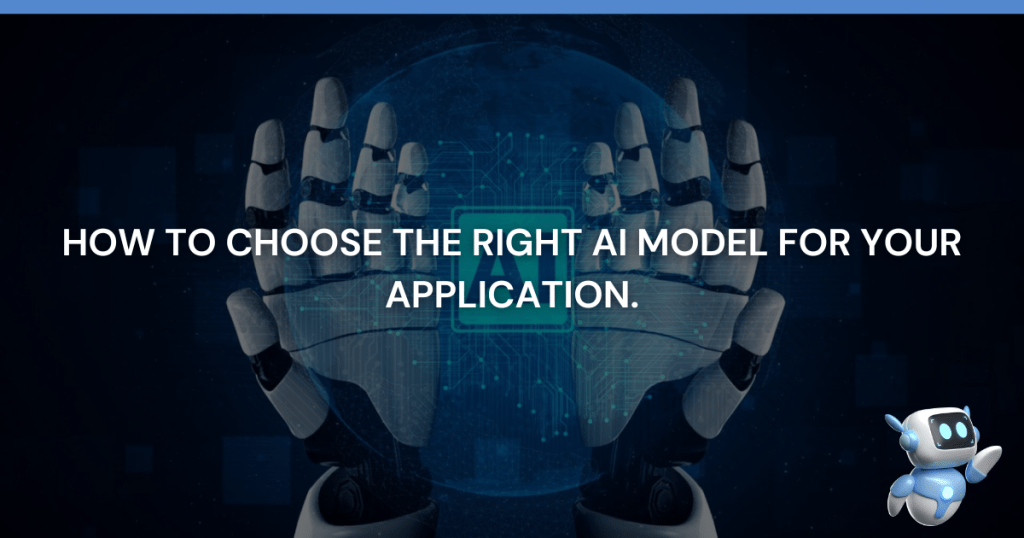In the rapidly evolving world of Artificial Intelligence (AI), choosing the right AI model for your application can be a critical decision that impacts your project’s success. Whether you are developing a cutting-edge app, enhancing customer experiences, or automating business processes, selecting the appropriate AI model is essential. This guide will help you navigate the complexities and choose the best AI model for your specific needs.

Understand Your Application Requirements
Before diving into the selection of AI models, it’s crucial to have a clear understanding of your application requirements. Here are some questions to consider:
1. What problem are you trying to solve?
2. What type of data will you be working with?
3. What are the performance metrics for success?
4. What are your computational resources and constraints?
5. What level of interpretability do you need?
Having precise answers to these questions will guide you in narrowing down the appropriate AI models.
Types of AI Models
There are various types of AI models, each suited for different types of tasks. Here are some of the most common:
1. Supervised Learning Models
Supervised learning models are trained on labeled data, where the outcome is known. These models are ideal for tasks like classification and regression.
Linear Regression: Used for predicting continuous values.
Logistic Regression: Used for binary classification problems.
Decision Trees and Random Forests: Used for both classification and regression tasks.
Support Vector Machines (SVM):Used for classification tasks, especially in high-dimensional spaces.
Neural Networks: Used for complex tasks such as image and speech recognition.
2. Unsupervised Learning Models
Unsupervised learning models work with unlabeled data and are used for tasks like clustering and association.
K-Means Clustering: Used for partitioning data into clusters.
Hierarchical Clustering: Used for creating a hierarchy of clusters.
Principal Component Analysis (PCA): Used for dimensionality reduction.
Autoencoders: Used for anomaly detection and data compression.
3. Reinforcement Learning Models
Reinforcement learning models learn by interacting with an environment and receiving feedback through rewards or penalties. These models are ideal for tasks that involve decision-making and optimization.
Q-Learning: Used for learning the value of actions in a given state.
Deep Q-Networks (DQN): Combines Q-learning with deep neural networks for more complex tasks.
Policy Gradient Methods: Used for directly optimizing the policy.
4. Transfer Learning Models
Transfer learning models leverage pre-trained models on large datasets and fine-tune them for specific tasks. These models are beneficial when you have limited data.
BERT and GPT: Used for natural language processing tasks.
VGG, ResNet, and Inception: Used for image classification and recognition tasks.
Factors to Consider When Choosing an AI Model
1. Accuracy
Accuracy is a crucial factor in choosing an AI model. Evaluate the performance of different models on your dataset to determine which one yields the best results.
2. Interpretability
For some applications, especially in healthcare and finance, interpretability is vital. Models like decision trees and linear regression offer more interpretability compared to complex models like deep neural networks.
3. Scalability
Consider the scalability of the model, especially if you expect to handle large volumes of data. Models like random forests and neural networks can handle large datasets efficiently.
4. Training Time
Training time can be a constraint, especially with large datasets. Simpler models like logistic regression and decision trees are faster to train compared to complex models like deep neural networks.
5. Computational Resources
Evaluate the computational resources required by the model. Complex models like deep learning require significant computational power and specialized hardware like GPUs.
6. Availability of Data
The amount of data you have can influence the choice of the model. Transfer learning models are beneficial when you have limited data.
Read more https://www.leewayhertz.com/how-to-choose-an-ai-model/
Conclusion
Choosing the right AI model for your application involves understanding your requirements, evaluating different types of AI models, and considering factors like accuracy, interpretability, scalability, training time, computational resources, and data availability. By carefully considering these aspects, you can select the most suitable AI model to achieve your goals and drive success in your application. Whether you are working on a classification task, clustering, reinforcement learning, or transfer learning, the right AI model can make a significant difference in the performance and effectiveness of your application.
Read our latest Blog https://sharptechsolutions.co.uk/2024/08/05/https-sharptechsolutions-co-uk/
